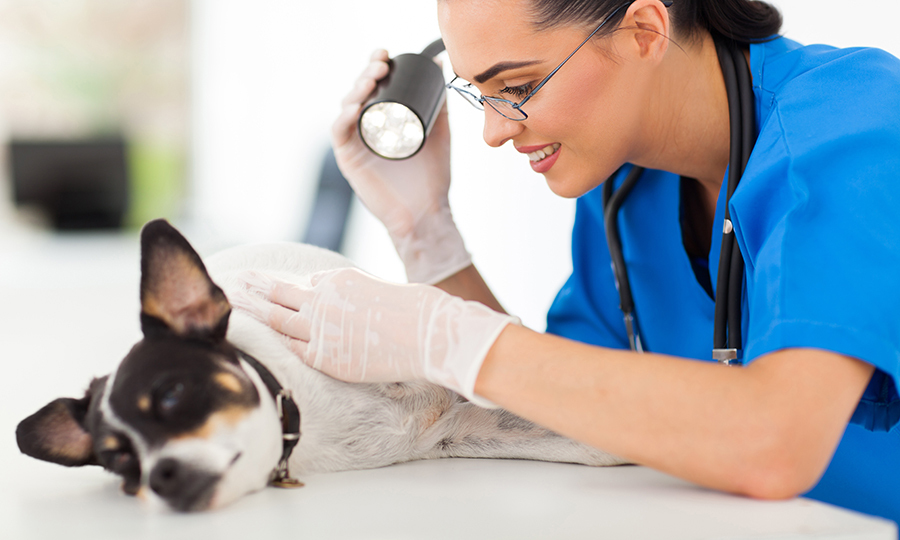DISEASES
Pyoderma in Dogs - Common Causes and Home Treatments
페이지 정보
본문


What is pyoderma in dogs?
Pyoderma is a bacterial infection that affects the skin of a dog. Often, pyoderma has an underlying cause, which can be an allergic skin disease or a parasitic infection. Papules and pustules, similar to human acne, appear in the form of red and raised bumps in cases of pyoderma. The severity of pyoderma will determine what type of treatment a dog with pyoderma will receive, which can include topical and oral medication. For cases of pyoderma that have an underlying cause, additional treatment may be required.
Causes of pyoderma in dogs
Bacteria are a normal part of a pet’s skin flora and do not cause any concern due to the body’s immune system’s ability to keep them from becoming harmful. However, if the surface of the skin is damaged, this can lead to bacterial infection. While superficial skin infections are common, some severe cases can cause symptoms such as pain and skin lesions.
Common causes of pyoderma in dogs are as follows:
-
Trauma or wound
Bacterial infection can occur due to a wound on the surface of the skin.
-
Allergic skin disease
Conditions such as atopy, food hypersensitivity, or flea bite hypersensitivity.
-
Infectious skin disease
Fleas, mites, fungal, parasitic infection, etc.
-
Systemic diseases that suppress the immune system
-
Endocrine disorders
Such as hypothyroidism, hyperadrenocorticism, Cushing’s disease, etc.
-
Immunosuppressive drugs
-
Skin folds and living environment
Bacteria can grow more easily between breeds that have many skin folds or if you reside in a warm, humid living environment.
-
Excessive licking
Areas that are frequently licked, such as paws and legs, are more likely to develop bacterial infections.
Symptoms of pyoderma in dogs

Depending on the cause of pyoderma in the dog, different symptoms may arise. You may notice the main characteristics of pyoderma in areas of the skin with many wrinkles or folds, the groin, armpits, and feet, as well as areas such as the mouth, jaw, joints, and between the toes.
Common symptoms caused by pyoderma in dogs are:
-
Papules and pustules
Papules and pustules look similar to human acne and are often red and raised. Papules refer to small lesions with clear boundaries and raised like a hill. Pustules look like raised lesions but are filled with pus.
-
Sacling, Scabbing, Crusting skin
-
Hair loss
-
Thickened skin
-
Hyperpigmentation
-
Bad smell between toes or skin folds
-
Signs of pain
-
Blood, if the infection gets deep within the skin
Risk of pyoderma in dogs and when to see a vet
Dogs with wrinkles and skin folds have a higher risk of developing pyoderma compared to dogs without them. This is particularly true for certain breeds with numerous wrinkles or skin folds caused by obesity. The heat between the wrinkles and moisture build-up creates an ideal environment for bacterial growth and infection. The areas where the skin folds are most common include the face, lips, tail, groin, armpits, and mammary glands of female dogs.
Several breeds, such as Spaniels, Pekingese, Pugs, Boxers, Bulldogs, and Shar-Pei, are particularly susceptible to pyoderma due to their numerous skin folds. Additionally, Shetland Sheepdog, Australian Shepherd, and Border Collie breeds may develop pyoderma accompanied by folliculitis, which can cause hair loss. Breeds such as German Shepherd, Bichon Frize, and Poodle breeds may develop pyoderma because of excessive mucus production on the skin, particularly around the mouth, nose, eyes, genitals, and anus.
It is important to note that pyoderma can be prone to occur in young puppies and older dogs as well, particularly those with weakened immune systems.
How to manage pyoderma in dogs at home
If skin problems are detected in your dog, it is advisable to begin by cleaning the living environment thoroughly. This can be achieved by replacing the bedding, especially the area where your dog sleeps, with clean dry covers. Additionally, if your dog is constantly scratching, biting, or licking their skin, using a neck collar can be helpful.
Diagnosing pyoderma in dogs

When you visit a veterinarian for suspicion of pyoderma, a veterinarian may inquire about the onset of skin lesions, and severity of itching, and assess any pre-existing condition or medication that may be contributing factors.
The following skin tests may be performed to diagnose pyoderma in dogs
-
Cytology test
This is the most commonly performed test. After gathering a sample from a skin scraping, using an acetate tape preparation, or collecting a cotton swab sample, the cells are observed under a microscope.
-
Skin bacterial culture and antibiotic sensitivity test
A veterinarian can proceed to identify the type of bacteria on your pet’s skin and choose the right antibiotic to treat it.
-
Biopsy
A skin biopsy is more invasive than a cytological examination and can provide the most accurate diagnosis. If a more accurate diagnosis is needed after cytological examination or if another underlying skin disease is suspected, a veterinarian may suggest a biopsy.
-
Blood tests
Underlying causes such as an endocrine disease can be identified through blood tests.
-
Diet
If a food allergy is suspected, a food elimination diet may be performed for diagnosis. Other non-allergenic protein sources and hydrolyzed protein feeds can be fed during this process.
How to treat pyoderma in dogs
Pyoderma typically responds to treatment within 3 to 4 weeks, although in severe cases, treatment may extend for several months. The primary approach to managing pyoderma involves the use of topical and oral medications.
-
Topical medication
A veterinarian has several topical options to treat a skin condition. They can prescribe an ointment, spray, or use a medicated shampoo safe for pets. Medicinal shampoos typically contain benzoyl peroxide, sulfur, salicylic acid, or chlorhexidine, and can be applied to the skin for at least 10 minutes. Medicated shampoo can effectively remove germs and crusts, while also relieving itchiness, odor, and excess oil.
-
Oral medication
Antibiotics are commonly prescribed for pyoderma, with a typical duration of 3-4 weeks. Some commonly used antibiotics include amoxicillin, cephalexin, and clindamycin. However, if the condition is chronic and recurrent, appropriate antibiotics should be selected based on bacterial culture and antibiotic susceptibility testing, and the duration of treatment may be extended to 8-12 weeks. It is important to continue taking the medication as prescribed, even if symptoms do not improve. Additionally, depending on the symptoms, medications to relieve itching or inflammation may also be prescribed. If there is an underlying cause, such as allergic dermatitis, it is important to address it along with treating the pyoderma in your dog.
How to prevent pyoderma in dogs
Bacterial growth thrives in warm and humid environments, therefore, it is crucial to ensure that your puppy is dry at all times. Particularly after bathing, swimming, etc. Additionally, it is advisable to keep their hair short in areas that are prone to wrinkles or have severe skin lesions.
For individuals with an underlying disease that causes pyoderma, it is essential to monitor skin symptoms periodically. Early treatment of pyoderma is highly recommended to prevent the condition from progressing.
Find out more about your dog’s symptoms and diseases on the Buddydoc app!

The Buddydoc library is filled with everything you’d want to know about each symptom and disease your pet may experience. If you would like to find out more about the causes, signs, treatments, preventions, and more for your dog’s disease. Try out the Buddydoc app and search for your pet’s symptoms or diseases in the Buddydoc library.













